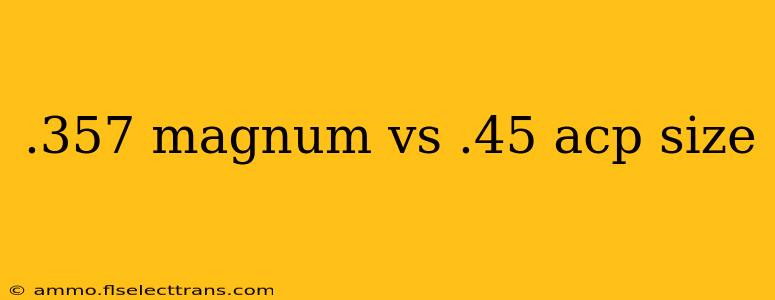Choosing between a .357 Magnum and a .45 ACP often comes down to personal preference and intended use. While both are powerful handgun cartridges, their size and resulting characteristics differ significantly. This comparison focuses on the physical dimensions of the cartridges themselves, clarifying the size discrepancies.
Cartridge Dimensions: A Head-to-Head
Let's dive into the specifics of cartridge size, examining key measurements:
Overall Length
- .357 Magnum: Approximately 1.29 inches (32.77 mm)
- .45 ACP: Approximately 1.27 inches (32.26 mm)
While seemingly negligible, the slight difference in overall length can impact magazine capacity and the overall dimensions of the firearm. The .357 Magnum's slightly longer length reflects its longer case, accommodating more propellant.
Case Diameter
This is where a significant visual difference becomes apparent.
- .357 Magnum: Approximately 0.357 inches (9.07 mm) – This refers to the bullet diameter, not the case. The case is wider.
- .45 ACP: Approximately 0.452 inches (11.48 mm) – This also refers to the bullet diameter, not the case. The case, like the .357, is also wider than the bullet diameter.
The .45 ACP's larger case diameter is immediately noticeable. This wider case holds a substantially larger volume of powder, contributing to its greater stopping power.
Bullet Diameter
Although both cartridges are frequently associated with their bullet diameter, it's vital to remember this is just one aspect of their size.
- .357 Magnum: 0.357 inches (9.07 mm)
- .45 ACP: 0.452 inches (11.48 mm)
The significant difference in bullet diameter is directly related to the cartridge's impact on a target. The larger .45 ACP bullet creates a larger wound channel.
Case Volume
The case volume directly impacts the amount of propellant the cartridge can hold, influencing muzzle velocity and energy. While precise figures vary based on manufacturer and load, the .45 ACP generally has a noticeably larger case volume than the .357 Magnum. This, combined with its larger diameter bullet, contributes to the perception of the .45 ACP as a "hard-hitting" round.
Beyond the Numbers: Practical Implications
The size differences discussed above translate into several practical implications for firearm users:
- Recoil: The .357 Magnum, despite its smaller diameter, often exhibits higher recoil than the .45 ACP. This is partly due to its higher muzzle velocity.
- Concealed Carry: The overall dimensions of the firearm significantly affect concealability. Smaller .357 Magnum revolvers often exist, but larger capacity .45 ACP pistols can also be suitable for concealed carry depending on the design.
- Stopping Power: The .45 ACP’s larger bullet diameter and greater energy transfer typically lead to greater stopping power, though effective stopping power is multifaceted and dependent on shot placement.
- Magazine Capacity: Pistols chambered in .45 ACP often have lower magazine capacities than those chambered in .357 Magnum, due to the larger size of the cartridges.
Conclusion: More Than Just Size
While this comparison highlights the measurable size differences between the .357 Magnum and the .45 ACP cartridges, it's important to remember that ballistics, stopping power, and personal preference play crucial roles in cartridge selection. The best choice for you depends entirely on your intended application. Thorough research and practical experience are essential before making a final decision.

